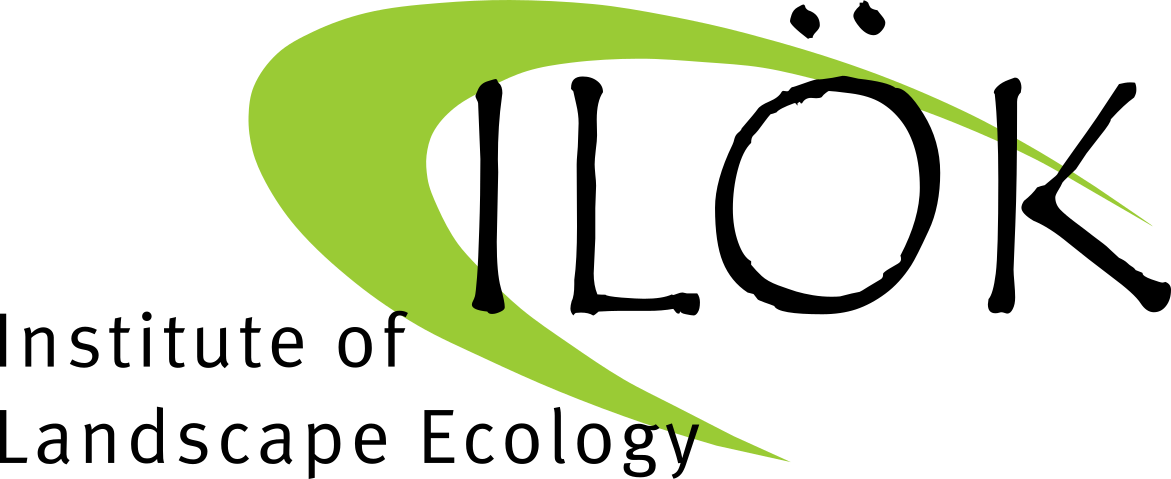Quantification and controls of carbon fluxes of the Windsborn lake (Eifel)
Are there 'hot spots' and 'hot moments' in the carbon cycle of shallow lakes?
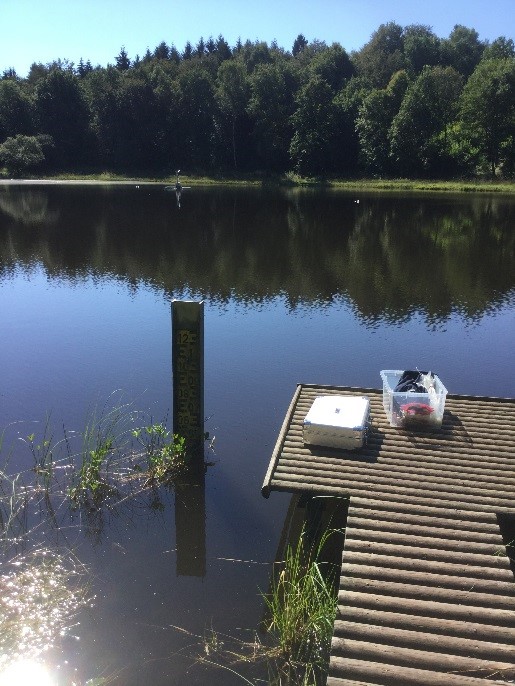
© Andreas Malkus Background
The German Research Foundation supports a research project of the Ecohydrology and Biogeochemistry working group (Prof. Dr. Klaus-Holger Knorr) for the investigation of the carbon cycle of shallow lakes using the example of crater lake Windsborn in the Eifel uplands, Germany.
Recent studies have shown that small and often shallow inland waters (< 100 ha) capture crucially larger areas than assumed formerly. Due to their frequency and high metabolic activity they are assumed to be significant sources of carbon dioxide (CO2) and methane (CH4) to the atmosphere and exhibit feedback mechanisms with climate change.
However, carbon fluxes are insufficiently quantified to date, regarding both spatial and temporal resolution of measurements. Further, climatic, hydrological and biological controls on emissions are inadequately captured.
The project will close these knowledge gaps by examining a model system and verify the hypothesis if times and zones of high fluxes exist which contribute significantly to the annual carbon balance.
Moreover, we will study methane production, oxidation and transport in the sediment and water column as key processes for the greenhouse effect of these systems.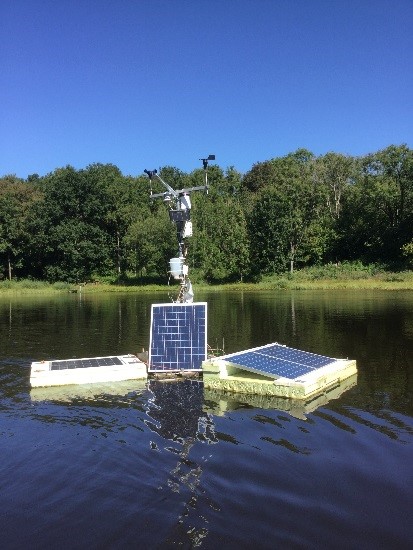
© Andreas Malkus Methods
In this project, we will apply different methods, from real-time measurements in the field to lab analyses and experiments.
A weather station installed at Lake Windsborn (see figure) will continuously measure weather parameters like temperature, precipitation and wind as well as CO2 concentrations in air and water column. With these data it is possible to calculate CO2 fluxes between water and atmosphere using the gradient (or thin boundary layer) method. Further, parameters in the water column (pH, conductivity, temperature, chlorophyll and oxygen content) will give more information about factors controlling CO2 emissions.
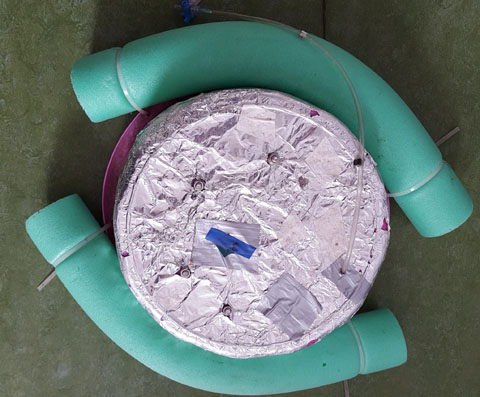
© Andreas Malkus To address the spatial and temporal variability of CO2 and CH4 emissions, small floating chambers will be installed distributed all over the lake surface (see figure) which will continuously measure CO2 concentrations. For determination of CO2, CH4 and N2O fluxes, gas samples will be taken from the chambers’ head space at regular intervals. To obtain more information about diurnal fluctuations of CO2 and CH4 emissions, a high temporal resolution greenhouse gas analyzer will be utilized to measure fluxes at specific dates throughout the year.
Production, oxidation and transport mechanisms of CO2 and CH4 in the sediment and water column will be identified using water, sediment and pore water analyses. For this purpose, samples taken in the field will be analyzed in the lab for concentrations, stable 13C isotopes and further for nutrients, trace elements, metals and organic matter. That way, dynamics and variability of the processes governing emissions can be accounted for. The contribution of methane ebullition to the total flux will be quantified with funnel traps.Students
In 2014 and 2015, two students‘ projects were conducted at Lake Windsborn, where first measurements to determine the carbon balance were performed.
If you are interested in writing a thesis or conducting a project, Prof. Dr. Klaus-Holger Knorr, Leandra Praetzel and Marcel Schmiedeskamp will provide further information. We have advertised possible topics for theses [de].
Theses
Finished theses
- Rebecca Pabst (B.Sc.-thesis): Spatiotemporal variability of CH4 and CO2 emissions at the small and shallow lake Heideweiher.
Ongoing theses
- Lukas Iking (B.Sc.-thesis): Influence of summer dry-out on carbon cycling the sediment of the “Heideweiher”, nature reserve “Heiliges Meer” – an incubation experiment
- Jasmin Gesing (B.Sc.-thesis): Insvestigating the influence of macrophyte growth (in particular Nymphaea alba) on the gas fluxes of carbon dioxide and methane in the shallow lake “Heideweiher” in the nature reserve “Heiliges Meer -Heupen”
- Sabrina Schilling (M.Sc.-thesis): Which factors control the spatial variability of methane emissions in Windsborn crater lake, Eifel?
- Nora Plenter (M.Sc.-thesis): Spatial variability and production processes of carbon dioxide and methane in the sediment of Windsborn crater lake, Volcanic Eifel
Interns
Within the DAAD Rise Germany program, we had great support from a student from the US during summer 2017. In 2018 two students from the US and Canada supported the project’s field and lab work.
Info
Project partners and contact
- University of Münster
- Institute of Landscape Ecology, Working group Ecohydrology and Biogeochemistry
Principal investigator: Prof. Dr. Klaus-Holger Knorr
PhD students: M.Sc. Leandra Praetzel, M.Sc. Marcel Schmiedeskamp
Project duration and funding
- Project duration: 11/2016 - 10/2019
- Funded by the German Research Foundation (DFG)
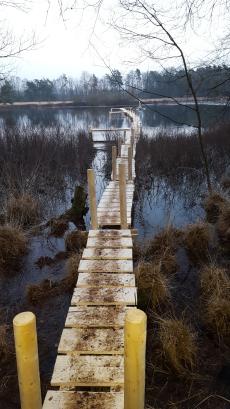
© Leandra Praetzel News
The field season 2017 was successfully completed. We are now waiting for the ice-melt to continue this year’s measurements.
This year, we will, additionally to lake Windsborn, conduct measurements at the shallow lake “Heideweiher” in the nature reserve “Heiliges Meer -Heupen” in Steinfurt county. The boardwalk for performing the measurements was already built in February, with energetic support of our research assistants.Since the end of December a weather station is installed at Lake Windsborn and recording data continuously.
Pictures
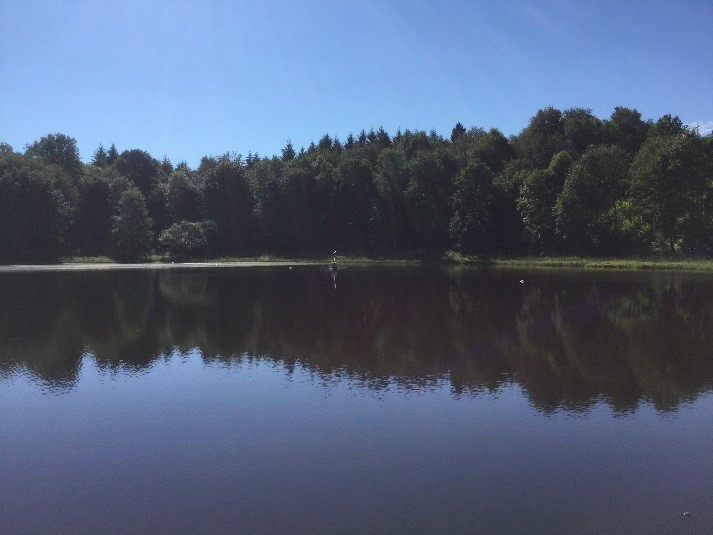
© Andreas Malkus Pictures
Please click on the picture for more impressions.

